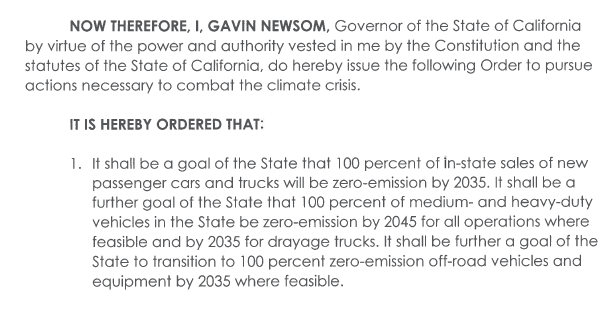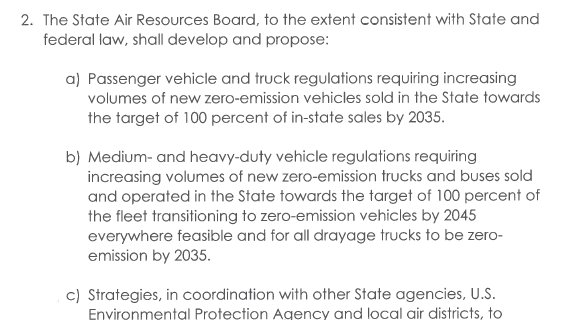Thanks to @jtemple for including me in his story on the big news from Governor Newsom& #39;s new executive order, which sets a goal of 100% zero emission new car and truck sales by 2035.
I& #39;ll do a deeper dive on the legal situation below. https://twitter.com/jtemple/status/1308923338107088896">https://twitter.com/jtemple/s...
I& #39;ll do a deeper dive on the legal situation below. https://twitter.com/jtemple/status/1308923338107088896">https://twitter.com/jtemple/s...
First thing to say is what an executive order (EO) is.
Generally, an EO can& #39;t create law. It can only direct policy outcomes that the law already allows.
EOs also set political goals around which laws more readily form. Most of California& #39;s major climate laws started as EOs.
Generally, an EO can& #39;t create law. It can only direct policy outcomes that the law already allows.
EOs also set political goals around which laws more readily form. Most of California& #39;s major climate laws started as EOs.
Today& #39;s EO sets a goal of having 100% of light-duty vehicles sold in California by 2035 be zero emissions vehicles (ZEVs). That& #39;s a big deal!
Medium- and heavy-duty vehicles get a longer runway: 100% by 2045 "where possible," hedging that other technologies may have a role to play here.
Drayage trucks, which serve California& #39;s massive ports and have big pollution impacts, get the earlier 2035 date.
Drayage trucks, which serve California& #39;s massive ports and have big pollution impacts, get the earlier 2035 date.
So those are the goals. What& #39;s the implementation pathway?
The EO directs the California Air Resources Board (CARB) to take action to implement the EO& #39;s goal via regulation.
The EO directs the California Air Resources Board (CARB) to take action to implement the EO& #39;s goal via regulation.
Lots of legal nuance here.
A good EO talks about consistency with state and federal law because EOs can& #39;t create or violate laws.
This EO references "technological feasibility" and "cost-effectiveness" because those terms are key under the federal Clean Air Act.
A good EO talks about consistency with state and federal law because EOs can& #39;t create or violate laws.
This EO references "technological feasibility" and "cost-effectiveness" because those terms are key under the federal Clean Air Act.
So the EO tells CARB to implement the EO& #39;s goals, subject to various legal considerations. CARB will need to evaluate what the law allows and see how far it can go in implementing the EO& #39;s directive. That could take a while and the result could be … well, anything at all.
Next up comes the tricky part. Section 209 of the Clean Air Act prohibits states from setting their own pollution standards for cars and trucks, but California has unique permission to go its own way when it gets a waiver from the EPA. https://www.law.cornell.edu/uscode/text/42/7543">https://www.law.cornell.edu/uscode/te...
Other states can follow the California standard if one exists, which is why California& #39;s leadership is so important on clean vehicles—under U.S. law, it& #39;s the only state that can go farther than the federal government. https://www.law.cornell.edu/uscode/text/42/7507">https://www.law.cornell.edu/uscode/te...
Problem is, Trump& #39;s EPA thinks the waiver the agency gave California during the Obama Administration is no good, and to make a very long story short, that fight is before the courts. https://www.latimes.com/california/story/2019-11-15/california-trump-administration-lawsuit-auto-emissions-climate-change">https://www.latimes.com/californi...
Interestingly, this is the same basic conflict California had with the Bush Administration over the state& #39;s first set of climate pollution standards for cars and trucks. That case was dismissed when the Obama Administration came to power and settled the fight.
Eventually, the Obama Administration coordinated a joint set of harmonized standards that applied both in California and the U.S. as a whole—with California& #39;s separately authorized by waiver in case, well, you know.
California now has to prevail in court or reach a favorable settlement with a friendly administration because it& #39;s going to need a waiver in place to implement whatever CARB decides to do in response to the EO.
So one way or another, EPA is going to have to get on board, too.
So one way or another, EPA is going to have to get on board, too.
There are many ways CARB could justify its future regulations, none of which is easily predicted right now. It& #39;s likely, however, that any future agreement between CARB and EPA about a waiver for the regulations implementing today& #39;s EO ends up in federal court.
(I suppose it& #39;s even possible that CARB pursues a legal path unrelated to the need for an EPA waiver. Can& #39;t think of one off the top of my head, but perhaps the lawyers at CARB have an idea in mind. Whatever the approach, it& #39;ll probably end up in court.)
It& #39;s also important to emphasize what this EO isn& #39;t.
As @daveregrets points out, it& #39;s not a ban on combustion vehicles. Nor does it address the vehicles people already own, or want to buy or sell used—it& #39;s just a question of what new vehicles get sold in the future.
As @daveregrets points out, it& #39;s not a ban on combustion vehicles. Nor does it address the vehicles people already own, or want to buy or sell used—it& #39;s just a question of what new vehicles get sold in the future.
Meanwhile, there is nothing to force CARB to take action in response to the EO. I& #39;m not saying they don& #39;t want to, but the law does not compel them to achieve the EO& #39;s full goals. So one question is whether the Governor decides to back legislation to codify his EO as state law.
Previous bills seeking similar goals have fallen short in the legislature, but now the Governor has publicly backed an impressive and ambitious target. Will he also help push a bill to make his EO law in California and reinforce the task he& #39;s assigned to CARB?
When I said earlier that many of California& #39;s most famous climate laws were born as EOs, that& #39;s true—making them law is what made them matter in the long run. But there are plenty of bold EOs that never went anywhere.
I& #39;m excited here, but watching what happens next.
I& #39;m excited here, but watching what happens next.
So to recap:
- Executive Order sets goal of 100% clean vehicles
- Directs CARB to issue a regulation
- Likely requires EPA to grant a waiver to CARB
- Depends on how federal courts react
- Would be stronger as legislation
Congrats to all who made this path possible!
- Executive Order sets goal of 100% clean vehicles
- Directs CARB to issue a regulation
- Likely requires EPA to grant a waiver to CARB
- Depends on how federal courts react
- Would be stronger as legislation
Congrats to all who made this path possible!
Okay so I& #39;m sorry law is really complicated and politics are worse, but I& #39;m seeing a whole lot of "NO THE GOVERNOR CAN& #39;T DO THAT" and "YES HE HAS THE POWER" takes that are a bit off. Hopefully this thread makes it clear that only time and an election will tell.
PS here& #39;s the full text of the EO, which has a lot of other important stuff in it, too. I focused on the car standards because they implicate so many different areas of law and politics. https://www.gov.ca.gov/wp-content/uploads/2020/09/9.23.20-EO-N-79-20-text.pdf">https://www.gov.ca.gov/wp-conten...

 Read on Twitter
Read on Twitter



